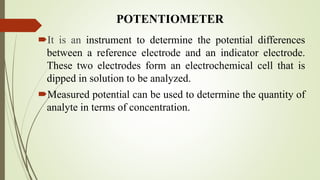The document presents an overview of potentiometry, a method in electro-analytical chemistry used to measure the potential difference between a reference and indicator electrode to determine the concentration of solutes in a solution. It details the types of electrodes used, including standard hydrogen, saturated calomel, and silver-silver chloride electrodes, along with their construction and working principles. Additionally, it discusses methods for endpoint detection in potentiometric titrations and highlights the advantages of potentiometric methods over traditional visual indicators.











![Reference electrode
Ⅰ. Standard hydrogen electrode (SHE)
Also known as Normal hydrogen electrode (NHE)
It is a gas-ion electrode [H2(g)/H+
(aq)]
It is a reference electrode set by IUPAC.
Ideal characters of the Reference electrode:
1) Obeys the Nernst equation.
2) Exhibit constant potential (0V)
3) Exhibit little change with temperature.
This electrode is conjugated with a sample/indicator electrode and measures the
concentration of analyte in the solution.](https://image.slidesharecdn.com/potentiometerybp1st1-240314134915-51ec34ea/85/Pharmaceutical-Analysis-Potentiometery-BP-12-320.jpg)


















